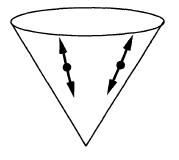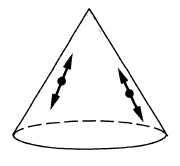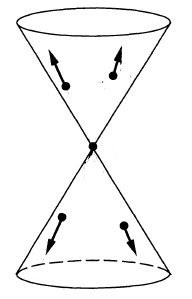nLab fundamental solution
Context
Differential geometry
synthetic differential geometry
Introductions
from point-set topology to differentiable manifolds
geometry of physics: coordinate systems, smooth spaces, manifolds, smooth homotopy types, supergeometry
Differentials
Tangency
The magic algebraic facts
Theorems
Axiomatics
Models
differential equations, variational calculus
Chern-Weil theory, ∞-Chern-Weil theory
Cartan geometry (super, higher)
Functional analysis
Overview diagrams
Basic concepts
Theorems
Topics in Functional Analysis
Contents
Idea
Given a linear differential operator (ordinary or partial) on a domain or a manifold , one can consider both the homogeneous differential equation and the nonhomogeneous equation of the form where is a given nonhomogeneous term. If is a delta distribution and the boundary conditions are given, then the generalized solution of the nonhomogenous equation
is called the fundamental solution for ; alternative names like Green function and function of influence are also used. A particular solution of the nonhomogeneous equation for some other can be obtained by calculating the convolution with the fundamental solution. (Compare the fact that the delta distribution is the identity element for convolution.)
As a first step one may also considers searching for such that is a smooth function, the solution to the latter problem is called a parametrix.
Examples
Propagators for free fields
The Green functions for the wave operator/Klein-Gordon operator are known as the propagators for free fields in field theory:
propagators (i.e. integral kernels of Green functions)
for the wave operator and Klein-Gordon operator
on a globally hyperbolic spacetime such as Minkowski spacetime:
Properties and results
(Malgrange-Ehrenpreis theorem) If is a differential operator with constant coefficients in -dimensional real space then the fundamental solution exists in the Schwarz space . The proof is using Fourier transform which sends the equation for the fundamental solution into an algebraic equation for the Fourier transform of the solution seeked; the algebraic equation requires inversion and one checks that the conditions for finding the inverse in the Schwarz space are satisfied.
Related concepts
References
-
Lars Hörmander, section 3.3 of The analysis of linear partial differential operators, vol. I, Springer 1983, 1990
-
Sergiu Klainerman, chapter 4 of Lecture notes in analysis, 2011 (pdf)
-
Christian Bär, Nicolas Ginoux, Frank Pfäffle, section 2 and 3 of Wave Equations on Lorentzian Manifolds and Quantization, ESI Lectures in Mathematics and Physics, European Mathematical Society Publishing House, ISBN 978-3-03719-037-1, March 2007, Softcover (arXiv:0806.1036)
-
Nicolas Ginoux, Linear wave equations, Ch. 3 in Christian Bär, Klaus Fredenhagen, Quantum Field Theory on Curved Spacetimes: Concepts and Methods, Lecture Notes in Physics, Vol. 786, Springer, 2009
-
Igor Khavkine, section 2 of Covariant phase space, constraints, gauge and the Peierls formula, Int. J. Mod. Phys. A, 29, 1430009 (2014) (arXiv.1402.1282)
-
Wikipedia, Fundamental solution
-
Wikipedia, Green’s functions
Last revised on August 1, 2018 at 12:24:44. See the history of this page for a list of all contributions to it.



